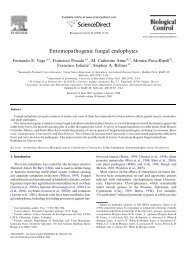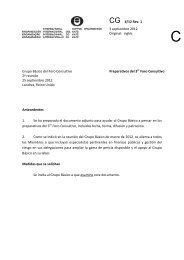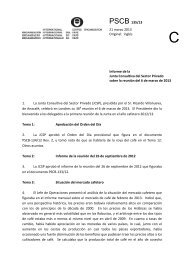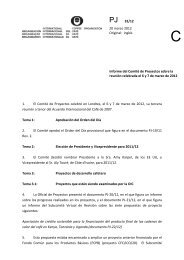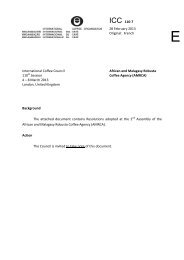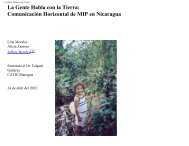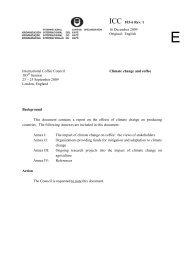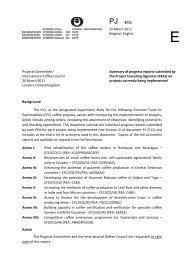Devouring profit - International Coffee Organization
Devouring profit - International Coffee Organization
Devouring profit - International Coffee Organization
Create successful ePaper yourself
Turn your PDF publications into a flip-book with our unique Google optimized e-Paper software.
estimated at 6%. Colombia’s principal export earners in 2000 were petroleum products<br />
(US$4.72 billion) and coal (US$1.09 billion).<br />
<strong>Coffee</strong> growers in Colombia total 450,000 families and it is clear that many of them<br />
are living almost entirely from coffee. This fact makes coffee very important from the<br />
social point of view. Additionally coffee is believed to generate almost one extra<br />
direct employment per hectare per year which equals about 800,000 jobs per year. If<br />
we take into account the various indirect effects, total jobs due to coffee will be<br />
significantly higher than this figure.<br />
Annual coffee production in Colombia has increased from 7.7 million bags in the<br />
1960s to a peak of 18.1 million bags in 1991/92. Increases in plantings and production<br />
were encouraged by the Federation. However, due to a combination of the effect of<br />
low prices (both in the early 1990s and since 2000), rising costs of production and the<br />
impact of CBB, production has since declined. In 2000/01, production was 10.5<br />
million bags, over 40% lower than in 1991/92, while the average yield was 877 kg per<br />
hectare (Figure 26). Yields have improved from the 1960s and 1970s level of around<br />
600 kg per hectare mainly as a result of the increased use of higher yielding varieties,<br />
which are more densely planted and yield around 1,200 kg per hectare, compared to<br />
traditional varieties which may typically yield around 300 kg per hectare. Replanting<br />
and crop renovation have been supported by government subsidies since 1994/95,<br />
aimed at improving yields rather than increasing planted area. Over the last ten years,<br />
the coffee-planted area has declined from over 1.1 million hectares to 0.8 million<br />
hectares, while the area harvested has been 6-15% lower than this, depending on a<br />
number of factors, including crop renovation programmes.<br />
<strong>Coffee</strong> Sacks<br />
7,000,000<br />
6,000,000<br />
5,000,000<br />
4,000,000<br />
3,000,000<br />
88-89<br />
90-91<br />
92-93 94-95<br />
<strong>Coffee</strong> years<br />
96-97<br />
98-99<br />
Figure 25. <strong>Coffee</strong> production in Mexico, 1988-89 to 1999-00 41 .<br />
41 Source: Mexican <strong>Coffee</strong> Council, 2001<br />
105




